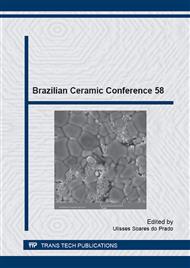p.218
p.225
p.231
p.239
p.244
p.250
p.256
p.262
p.268
Evaluation of the Thermomechanical Behavior of Metallic Interconnectors Coated with a Film of La0,8Ca0,2CrO3 of Solid Oxide Fuel Cells (SOFC)
Abstract:
Doped lanthanum chromite has been the most common material used as interconnectors in solid oxide (SOFC) fuel cell, allowing for the stacking of the SOFC. Reducing the operating temperature, to around 800°C, the cells of solid oxide fuel have made the use of metal interconnectors possible as an alternative to ceramic LaCrO3. From the practical point of view for the material to be a strong candidate as an interconnector, it must have good physical and mechanical properties, such as resistance to oxidizing environments and reducers, facility to manufacture, and adequate thermomechanical properties. In this work, a study was conducted on the thermomechanical properties of metallic interconnectors (AISI 444) covered with La0,8Ca0,2CrO3 by way of deposition technique for pyrolysis spray for the intermediate temperature (IT-SOFC) fuel cell. The material was characterized by X-ray diffraction (XRD), oxidative test, flexural strength at room temperature and at 900°C, and scanning electron microscopy (SEM). The evaluation of the phases formed on metallic interconnectors coated with La0,8Ca0,2CrO3 on both the deposition and after oxidative assay was performed by XRD. The oxidative behavior showed increased resistance to oxidation of the metal substrate covered by La0,8Ca0,2CrO3. In the flexural strength of the coated metal substrate, it was noted only in the increasing temperature. With the aid of SEM, the formation of layers of Cr2O3 and (Cr, Mn)3O4 on the metallic substrate was seen, and confirmed stability of La0,8Ca0,2CrO3 ceramic film after oxidative test.
Info:
Periodical:
Pages:
244-249
Citation:
Online since:
June 2015
Price:
Сopyright:
© 2015 Trans Tech Publications Ltd. All Rights Reserved
Share:
Citation:


